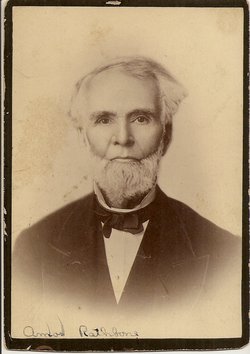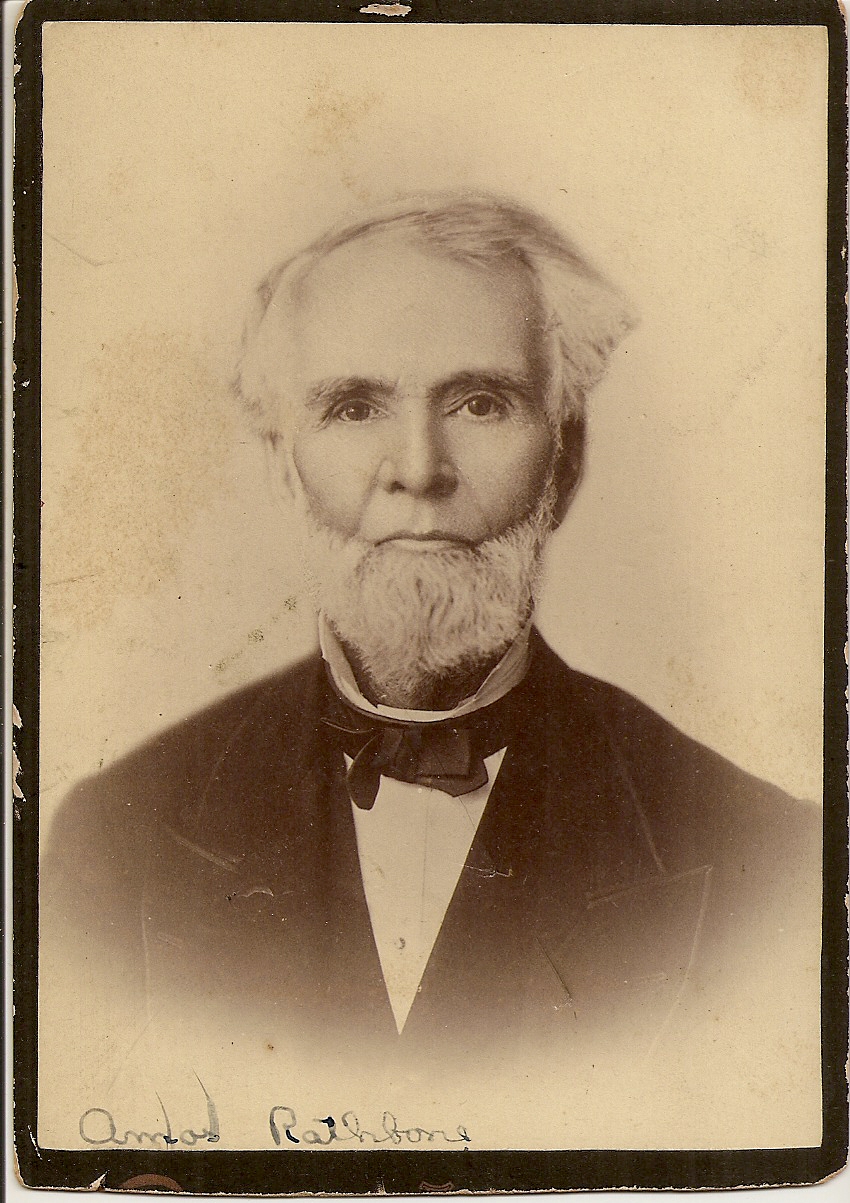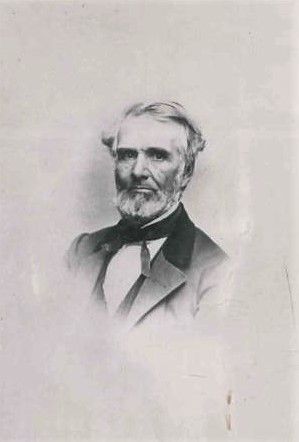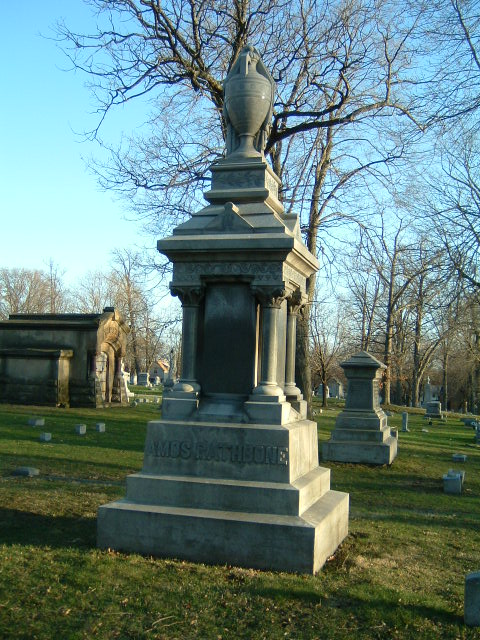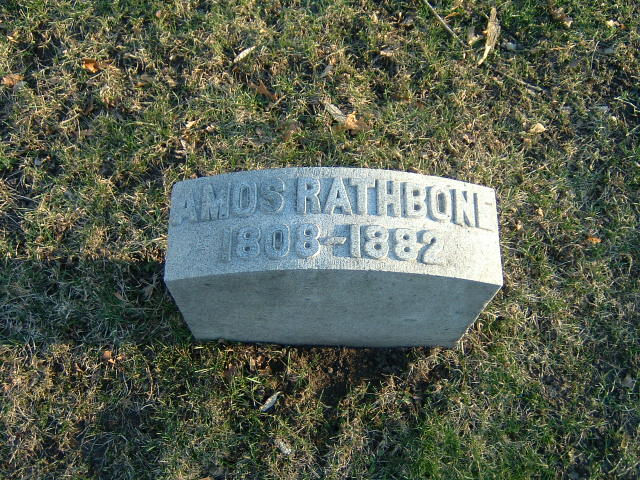November 20, 1882
One More Gone - Amos Rathbone
In this paper is announced 20 Nov. the death of Amos Rathbone, another of the Old Residents and a man of prominent in this city for about forty-five years. He had long been in poor health, and of late so much prostrated that for some time his friends had abandoned hope of his permanent recovery. Amos Rathbone was born at Scipio, Cayuga County, New York October 14, 1808. He was a farmer and his education was that of the common district school. About 1834 he went to Covington Indiana and engaged in business as a merchant. A year or two later he visited Grand Rapids, and here purchased for $400 two lots on what was then called "Prospect Hill" being the place afterward owned by his brother A. D. Rathbone, and of late by Hon. Wm. T. Powers. South West corner of Lyons and Ottawa Streets. For two or three years he carried on a desultory trade between Grand Rapids and his Covington home. In the fall of 1839, hearing of the loss of a large quantity of supplies, provisions and groceries, on their way hither by a lake disaster, and of consequent need among the settlers here, Mr Rathbone loaded heavy wagon, and with seven yoke of oxen came through from Indiana, bringing other cattle also, about fifty head in all, and several horses. In 1840 he built the stone block at the junction of Monroe and Justice (now Ottawa) Street, so many years known as the "Rathbone Building" and sometimes called "The Wedge" since destroyed by fire, and rebuilt with brick. Where the Union ticket office now is. It was some years from that before the place grew up to make such a block profitable in a business point of view. Mr. Rathbone about that time went into lumbering operations, on the Rouge River at Laphamville (now Rockford) also on the White River, taking interest in several mills and shipping to the Chicago market. After the war in 1865, he took an interest in the plaster business, with George H. White and others, in the Plaster Creek quarries, which he retained till about two years ago. Meantime he began building business blocks on the lots North side of Monroe Street between Ionia and Division, which he had previously for a long time owned - built some twelve or fifteen stories, three stories high eleven of which be still owned at the time of his death. His handsome stone cottage homestead, a short distance South of St Mark's Church, has been a prominent attraction in that part of the city for a quarter of a century. Owing to failing health and growing infirmity he retired from active business some two years ago. For over a quarter of a century he has been prominent among the property men of the city, and one taking an interest in all that pertained to its growth and welfare. A quiet, nostentatious, upright citizen, and good neighbor, having respect of the entire community. In politics he was an earnest, stanch Republican, from the formation of the party onward. Watching the fortunes of the party, rejoicing in its prosperity and feeling its reverse almost as if they were his own family. He was not partial toward the Episcopal, with which several personally identified with any church, but part of his relatives were connected. He married in 1845 Amanda Carver, who survives him. An older sister is Mrs. Thomas Y. Howe of Brownsville New York, and his brother William is a resident of Auburn in that state. A younger sister is the widow of George A. Bennedict. In his life time of many years editor of Cleveland Herald. Though passed from this earth, he will be long remembered by Hosts of Friends.
History of the City of Grand Rapids Michigan by Albert Baxter 1891
p. 105
Amos Rathbone was born in Scipio, N. Y., October 14, 1808, and was among the pioneers of Grand Rapids. He visited here about 1836, and purchased two lots on Prospect Hill, next to Lyon street, for which he paid $400; afterward for two or three years he spent a portion of the time in Indiana. In 1839, provisions being scarce here, he loaded a wagon and came through with seven yoke of oxen, and also brought with him fifty head of cattle and half a dozen horses, and he continued in similar traffic between this place and Indiana two or three years. About 1842, with Gouverneur B. Rathbun, he opened a store on Monroe street, opposite the head of Waterloo street and in the following year they built a stone block on the north corner of Monroe and Ottawa streets, of size sufficient for three or four stores, for many years familiarly known as the Rathbone Building, or "The Wedge" At that time this building was thought too costly and massive to ever pay profit. It was burned in the great fire of 1857, and in its place stands a fine brick block. For many years he was extensively engaged in the lumber trade north of this river. In 1868 and until 1880 he was financially interested in the plaster business. He also built twelve stores on the north side on Monroe street, below Division. Mr Rathbone died in 1882, venerable in years, and a very few, if any, have left a deeper impress upon the growth and development of this city. He married in 1845, Amanda Carver, born in Scipio, N. Y., in 1810, who survives him. He was a man of strong convictions and upright character, with whom to say was to do. He was prominently and actively identified with the growth of the city and the development of its material resources during almost half a century.
November 20, 1882
One More Gone - Amos Rathbone
In this paper is announced 20 Nov. the death of Amos Rathbone, another of the Old Residents and a man of prominent in this city for about forty-five years. He had long been in poor health, and of late so much prostrated that for some time his friends had abandoned hope of his permanent recovery. Amos Rathbone was born at Scipio, Cayuga County, New York October 14, 1808. He was a farmer and his education was that of the common district school. About 1834 he went to Covington Indiana and engaged in business as a merchant. A year or two later he visited Grand Rapids, and here purchased for $400 two lots on what was then called "Prospect Hill" being the place afterward owned by his brother A. D. Rathbone, and of late by Hon. Wm. T. Powers. South West corner of Lyons and Ottawa Streets. For two or three years he carried on a desultory trade between Grand Rapids and his Covington home. In the fall of 1839, hearing of the loss of a large quantity of supplies, provisions and groceries, on their way hither by a lake disaster, and of consequent need among the settlers here, Mr Rathbone loaded heavy wagon, and with seven yoke of oxen came through from Indiana, bringing other cattle also, about fifty head in all, and several horses. In 1840 he built the stone block at the junction of Monroe and Justice (now Ottawa) Street, so many years known as the "Rathbone Building" and sometimes called "The Wedge" since destroyed by fire, and rebuilt with brick. Where the Union ticket office now is. It was some years from that before the place grew up to make such a block profitable in a business point of view. Mr. Rathbone about that time went into lumbering operations, on the Rouge River at Laphamville (now Rockford) also on the White River, taking interest in several mills and shipping to the Chicago market. After the war in 1865, he took an interest in the plaster business, with George H. White and others, in the Plaster Creek quarries, which he retained till about two years ago. Meantime he began building business blocks on the lots North side of Monroe Street between Ionia and Division, which he had previously for a long time owned - built some twelve or fifteen stories, three stories high eleven of which be still owned at the time of his death. His handsome stone cottage homestead, a short distance South of St Mark's Church, has been a prominent attraction in that part of the city for a quarter of a century. Owing to failing health and growing infirmity he retired from active business some two years ago. For over a quarter of a century he has been prominent among the property men of the city, and one taking an interest in all that pertained to its growth and welfare. A quiet, nostentatious, upright citizen, and good neighbor, having respect of the entire community. In politics he was an earnest, stanch Republican, from the formation of the party onward. Watching the fortunes of the party, rejoicing in its prosperity and feeling its reverse almost as if they were his own family. He was not partial toward the Episcopal, with which several personally identified with any church, but part of his relatives were connected. He married in 1845 Amanda Carver, who survives him. An older sister is Mrs. Thomas Y. Howe of Brownsville New York, and his brother William is a resident of Auburn in that state. A younger sister is the widow of George A. Bennedict. In his life time of many years editor of Cleveland Herald. Though passed from this earth, he will be long remembered by Hosts of Friends.
History of the City of Grand Rapids Michigan by Albert Baxter 1891
p. 105
Amos Rathbone was born in Scipio, N. Y., October 14, 1808, and was among the pioneers of Grand Rapids. He visited here about 1836, and purchased two lots on Prospect Hill, next to Lyon street, for which he paid $400; afterward for two or three years he spent a portion of the time in Indiana. In 1839, provisions being scarce here, he loaded a wagon and came through with seven yoke of oxen, and also brought with him fifty head of cattle and half a dozen horses, and he continued in similar traffic between this place and Indiana two or three years. About 1842, with Gouverneur B. Rathbun, he opened a store on Monroe street, opposite the head of Waterloo street and in the following year they built a stone block on the north corner of Monroe and Ottawa streets, of size sufficient for three or four stores, for many years familiarly known as the Rathbone Building, or "The Wedge" At that time this building was thought too costly and massive to ever pay profit. It was burned in the great fire of 1857, and in its place stands a fine brick block. For many years he was extensively engaged in the lumber trade north of this river. In 1868 and until 1880 he was financially interested in the plaster business. He also built twelve stores on the north side on Monroe street, below Division. Mr Rathbone died in 1882, venerable in years, and a very few, if any, have left a deeper impress upon the growth and development of this city. He married in 1845, Amanda Carver, born in Scipio, N. Y., in 1810, who survives him. He was a man of strong convictions and upright character, with whom to say was to do. He was prominently and actively identified with the growth of the city and the development of its material resources during almost half a century.
Family Members
Advertisement
Advertisement
